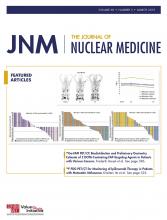Discussions with leaders: JNM editor-in-chief Johannes Czernin continues a series of interviews with leaders in nuclear and molecular imaging and therapy with a conversation with Simon Cherry.
Page 295
Human total-body PET: Badawi and colleagues present the first human imaging studies on the EXPLORER scanner, using a range of different protocols that provide foundational evidence for future trials to evaluate improvements and innovations facilitated by total-body PET imaging.
Page 299
H&N perineural spread imaging: Lee and colleagues provide an educational overview of tumor growth along large nerves and the role of 18F-FDG PET in assessment of perineural spread in head and neck cancer.
Page 304
11C-MET PET in DIPG: Tinkle and colleagues investigate uptake of 11C-methionine in pediatric patients with newly diagnosed diffuse intrinsic pontine glioma and explore associations between PET metrics, conventional MR imaging, and survival.
Page 312
Ki estimates from static PET: Doot summarizes previous reports on changes in primary breast cancer tumor and SUVs from serial 18F-FDG PET scans and patient outcomes and previews a related article in this issue of JNM.
Page 320
18F-Fluoride Ki, SUV, and bone metastases: Azad and colleagues determine whether PET/CT measurement of changes in 18F-fluoride metabolic flux to bone mineral, compared with SUVmax and SUVmean, can improve response assessment of bone metastases in breast cancer.
Page 322
18F-FDG PET response criteria in NSCLC: Turgeon and colleagues compare survival outcomes according to 4 international criteria for defining response with 18F-FDG PET after curative-intent chemoradiation for non–small cell lung cancer.
Page 328
Ipilimumab response using imPERCIST5: Ito and colleagues assess associations between tumor response on 18F-FDG PET/CT and prognosis in patients with metastatic malignant melanoma treated with ipilimumab.
Page 335
Scintigraphy and TIRADS: Schenke and colleagues look at the value of the addition of thyroid scintigraphy to the Thyroid Imaging Reporting and Data System to avoid unnecessary fine-needle biopsies and thyroid surgeries.
Page 342
HK2 expression in multiple myeloma imaging: Kircher and colleagues explore reasons for PET false-negativity with both 18F-FDG and 11C-methionine in patients with relapsed or refractory biopsy-proven and active multiple myeloma.
Page 348
PET and EGFR-targeted therapy: Burley and colleagues investigate human epidermal growth factor receptor 1–specific radioligands for measurement of EGFR expression across the entire tumor burden in head and neck cancer and for monitoring of cetuximab-mediated changes in receptor expression.
Page 353
18F-PSMA-1007 PET/CT in PCa restaging: Giesel and colleagues evaluate the diagnostic efficacy of 18F-PSMA-1007 PET/CT for biochemical recurrence after radical prostatectomy in 251 patients.
Page 362
Somatostatin PET in PPGLs: Han and colleagues report on a systematic review and metaanalysis of the performance of 68Ga-DOTA–conjugated somatostatin receptor–targeting peptide PET in detection of pheochromocytomas and paragangliomas.
Page 369
PRRT in G3 neuroendocrine neoplasms: Zhang and colleagues analyze long-term outcomes, efficacy, and safety of peptide-receptor radionuclide therapy in patients with somatostatin receptor–expressing grade 3 neuroendocrine neoplasms.
Page 377
68Ga-FAPI PET/CT: Giesel and colleagues detail tissue biodistribution and preliminary dosimetry of DOTA-containing fibroblast activation protein–targeting agents in patients with various cancers.
Page 386
177Lu-Labeled minigastrin: Sauter and colleagues investigate whether a chemically stabilized analog performs better than reference analogs in cholecystokinin-2 receptor targeting in metastatic medullary thyroid cancer in basic, translational, and first-in-human studies.
Page 393
111In-DOTA-5D3 SPECT for PSMA: Banerjee and colleagues characterize this new high-affinity murine monoclonal antibody targeting prostate-specific membrane antigen using SPECT/CT imaging, tissue biodistribution studies, and dosimetry.
Page 400
PET and stable CAD management: Di Carli and Hachamovitch provide perspective on ischemia-guided approaches in management of stable coronary artery disease and preview an article in this issue of JNM on PET-assessed quantitative flow measurements.
Page 407
Cardiac PET and coronary revascularization: Gould and colleagues research the threshold of quantitative myocardial perfusion severity for association with reduced death, myocardial infarction, or stroke after revascularization within 90 days after PET.
Page 410
Clinical translation of NIR tracers: Linssen and colleagues describe their development and production process for near-infrared agents cetuximab-800CW and trastuzumab-800CW and provide a roadmap for developing monoclonal antibody tracers into regulatory-compliant drug products.
Page 418
Photonuclear production of 15O: Queern and colleagues report on a novel and economical approach to production of 15O for PET applications using an electron linear accelerator.
Page 424
DIVIDE pseudo-CT for pelvis PET/MR AC: Torrado-Carvajal and colleagues describe a deep-learning network for synthesis of pelvis pseudo-CT maps based on standard Dixon volumetric-interpolated breath-hold images currently acquired for attenuation correction in some commercial scanners.
Page 429
- © 2019 by the Society of Nuclear Medicine and Molecular Imaging.







